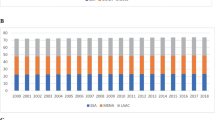Abstract
In this paper, we investigate the relationships between trade and labor productivity for nine Latin American countries in terms of the trade-led growth hypothesis. We use a vector error-correction model and perform independent tests of the short-run and long-run relationship among exports, imports and productivity to examine the direction of causality. The results show that exports and imports have impacts on labor productivity. We find evidence that the export‐led growth hypothesis is significant for Bolivia, Chile and Mexico; the growth‐led export hypothesis is significant for Uruguay; the import‐led growth hypothesis is relevant for Brazil, Colombia and Mexico; and the growth‐led import hypothesis is relevant for Brazil, Colombia and Uruguay. Finally, we note an important role of imports in the long-run development of these economies.

Similar content being viewed by others
Notes
Available at: https://data.worldbank.org/.
Available at: https://www.conference-board.org/data/economydatabase/.
Value added data are not available for Uruguay, Argentina and Mexico for the entire time span, so we used data for these countries according to availability.
For this, the Wald test is used under the null hypothesis \({H}_{0}: {\alpha }_{i,j}=0, {\uptheta }_{i,j}=0\).
In this case, the test has two cointegrating vectors (\(r=2\)), in which \(({\beta }_{\mathrm{2,1}}/{\beta }_{\mathrm{1,1}})\) is the \({X}_{t-1}\) normalized coefficient of the first cointegrating vector and \({\beta }_{\mathrm{2,2}}/{\beta }_{\mathrm{1,2}}\) is the \({X}_{t-1}\) normalized coefficient of the second cointegrating vector. If there is only one cointegrating vector (\(r=1\)), the significance is tested only over \({\beta }_{\mathrm{2,1}}/{\beta }_{\mathrm{1,1}}\). The magnitude of the cointegrating vectors will change with the normalizing variable, but the statistical significance will not change with normalization.
When \(r=1\), the test statistics follow \({\chi }^{2}\) with one degree of freedom.
When only one of the statistics presents significant values, we considered the series to be cointegrated, as in Peru, where only the trace statistic is significant at 5%.
For Chile and Ecuador, we estimate a difference VAR model, in which it is possible to test only the short run causality.
Data on the countries’ export baskets and economic complexity were consulted at The Observatory of Economic Complexity, available at: https://oec.world.
References
Awokuse TO (2008) Trade openness and economic growth: is growth export-led or import-led? Appl Econ 40(2):161–173
Beckerman W (1965) Demand, exports and growth In W. Beckerman & Associates (Eds.), The British economy in 1975 (pp 44–72) The National Institute of Economics and Social Research, Cambridge, UK: Cambridge University Press
Bhagwati JN (1988) Protectionism. MIT Press, Cambridge, MA
Cânedo-Pinheiro M (2013) Experiências comparadas de política industrial no pós- guerra: lições para o Brasil. In: Veloso F, Ferreira PC, Giambiagi F, Pessoa S (eds) Desenvolvimento Econômico: Uma Perspectiva Brasileira. Elsevier, Rio de Janeiro, pp 381–404
Charemza WW, Deadman DF (1992) New directions in econometric practice: general to specific modelling, cointegration and vector autoregression. Edward Elgar Publishing Ltd, Cheltenham, UK
Faleiros JPM, Alves DCO (2015) Reavaliando a relação entre produtividade e exportações através de modelo de correção de erros não linear: Evidências para Estados Unidos, Canadá. Japão e Alemanha Economia Aplicada 19(1):81–107
Hausmann R, Hwang J, Rodrik D (2007) What you export matters. J Econ Growth 12(1):1–25
Helpman E, Krugman PR (1985) Market structure and foreign trade. MIT Press, Cambridge, MA
Hye QMA, Wizarat S, Lau WY (2013) Trade-led growth hypothesis: an empirical analysis of South Asian countries. Econ Model 35:654–660
Johansen S (1991) Estimation and hypothesis testing of cointegrating vectors in Gaussian vector autoregressive models. Econometrica 59(6):1551–1580
Johansen S, Juselius K (1990) Maximum likelihood estimation and inference on cointegration – with application to demand for money. Oxford Bulletin Econ Statistics 52(2):168–210
Kaldor N (1970) The case for regional policies. Scottish J Political Econ 17(3):337–348
Kristjanpoller W, Olson JE (2014) Economic growth in Latin American countries: is it based on export-led or import-led growth? Emerg Mark Financ Trade 50(sup1):6–20
Krugman PR (1984) Import protection as export promotion: International competition in the presence of oligopoly and economies of scale. In: Kierzkowski H (ed) Monopolistic competition in international trade. Oxford University Press, Oxford, pp 180–193
Kunst RM, Marin D (1989) On exports and productivity: a casual analysis. Rev Econ Stat 71(4):699–703
Lancaster K (1980) Intra-industry trade under perfect monopolistic competition. J Int Econ 10(2):151–175
Maddala GS, Kim IM (1998) Unit roots, cointegration, and structural change. Cambridge University Press, Cambridge
Mahadevan R, Suardi S (2011) The effects of uncertainty dynamics on exports, imports and productivity growth. J Asian Econ 22(2):174–188
Marin D (1992) Is the export-led growth hypothesis valid for industrialized countries? Rev Econ Stat 74(4):678–688
Martin V, Hurn S, Harris D (2012) Econometric modelling with time series: specification, estimation and testing. Cambridge University Press, Cambridge
Nesset E (2004) Exports and productivity in a small open economy: a causal analysis of aggregate Norwegian data. J Policy Model 26(1):145–150
Silva IEM, Lima RC, Bezerra JF (2012a) As exportações promovem a produtividade? Evidência empírica para indústria de transformação do Brasil utilizando vetores autorregressivos com correção de erro (VEC). Economia 13(1):67–91
Silva IEM, Bezerra JF, Lima RC (2012b) Análise da relação entre importações e produtividade: evidência empírica para a indústria de transformação do Brasil. Revista De Economia Contemporânea 16(1):62–87
Temiz DD, Gökmen A (2019) Export-led economic growth and the case of Brazil: an empirical research. J Transnatl Manag 24(2):122–141. https://doi.org/10.1080/15475778.2019.1609895
Thangavelu SM, Rajaguru G (2004) Is there an export or import-led productivity growth in rapidly developing Asian countries? a multivariate VAR analysis. Appl Econ 36(10):1083–1093
Funding
The authors did not receive support from any organization for the submitted work.
Author information
Authors and Affiliations
Corresponding author
Ethics declarations
Ethical standards
The authors maintain the integrity of the research, complying with the rules of good scientific practices presented by the journal.
Additional information
Publisher's Note
Springer Nature remains neutral with regard to jurisdictional claims in published maps and institutional affiliations.
Appendix A
Appendix A
See Tables
7 and
8.
Rights and permissions
About this article
Cite this article
de Souza Nonato, V.L., Carrasco-Gutierrez, C.E. Trade-led growth hypothesis: evidence from Latin America countries. Empir Econ 64, 727–745 (2023). https://doi.org/10.1007/s00181-022-02266-w
Received:
Accepted:
Published:
Issue Date:
DOI: https://doi.org/10.1007/s00181-022-02266-w




